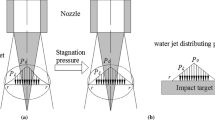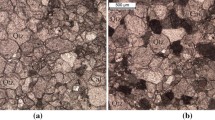Abstract
Fluid jets are increasingly used to process and machine tension-softening materials. Typical applications are drilling, cutting, fragmentation, hydrodemolition and 3D-machining. Tension-softening materials, such as concrete, reinforced ceramics, most rocks and solidified impurities, are quasi-brittle behaving materials characterised by a so-called fracture process zone. Therefore, linear elastic fracture mechanics does not suitably cover these materials. It is also known that conventional strength parameters, such as compressive strength, cannot describe the resistance of this group of materials against fluid jet erosion. In this paper, the behaviour of cement paste, mortar and concrete during the erosion by high-speed waterjets with velocities up to 470 m s−1 is investigated. The results of SEM-studies are presented that clearly illuminates features of quasi-brittle behaviour, including grain bridging, microcracking and crack branching. It is also found that the erosion process is strongly determined by the size of the aggregate (inclusions) in the material. It is concluded that a non-linear fracture resistance parameter may be suitable to estimate the erosion resistance of the material. It is found that the brittleness B M – the inverse of the characteristic length of a material – is a suitable resistance parameter. A very good relationship between the brittleness and the volumetric erosion rate estimated from 24 different types of concrete could be obtained.
Similar content being viewed by others
REFERENCES
Alfes, C. (1991). Relationship between the microstructure and fracture mechanics parameters of sandstone. In: Fracture Processes in Concrete, Rock and Ceramics (edited by J.G. van Mier et al.), E. & F.N. Spon. London, 73–82.
Bazant, Z.P. and Oh, B.H. (1983). Crack band theory for fracture of concrete. Materials and Structures 16, 155–177.
Brühwiler, E. and Saouma, V.E. (1995). Water fracture interaction in concrete – Part I: Fracture properties. ACI Materials Journal May–June, 296–303.
Harmuth, H. and Tschegg, E.K. (1997). Fracture mechanics approach for the development of refractory materials with reduced brittleness. Fatigue Fracture Engineering of Materials and Structures 20, 1585–1603.
Hillerborg, A. (1983). Analysis of a single crack. In: Fracture Mechanics of Concrete. (edited byWittmann, F.H.), Elsevier, Amsterdam 223–249.
Hillerborg, A., Modeer, M. and Petersson, P.-E. (1976). Analysis of crack formation and crack growth in concrete by means of fracture mechanics and finite elements. Cement and Concrete Research 6, 773–781.
Hilsdorf, H.K. and Brameshuber, W. (1991). Code-type formulation of fracture mechanics concepts for concrete. International Journal of Fracture 51, 61–72.
Hoagland, R.G., Hahn, G.T. and Rosenfield, A.R. (1973). Influence of microstructure on fracture propagation in rock. Rock Mechanics 5, 77–106.
Jenq, Y.S. and Shah, S.P. (1985). Two-parameter fracture model for concrete. ASCE Journal of Engineering Mechanics 111, 1227–1241.
Kauw, V. (1996). Optimierung des Einsatzes von Hochdruck-Wasserstrahl-Systemen bei der Betonuntergrundvorbereitung. Ph.D. thesis. RWTH Aachen, Aachen.
Linsbauer, H.N. (1991). Fracture mechanics material parameters of mass concrete based on drilling core testing – review and discussion. In: Fracture Processes in Concrete, Rocks and Ceramics (edited by van Mier J.G.) F&FN Spon, London, 779–787.
Momber, A.W. (ed.) (1998). Water Jet Applications in Construction Engineering. A.A. Balkema, Rotterdam.
Momber, A.W. (1998). Pre-evaluation of hydro-demolished concrete surfaces by drilled core testing. In: Proceedings 8th International Symposium on Concrete Roads, Theme IV, Lisbon, 7–14.
Momber, A.W. (2000). Concrete failure due to air-water jet impingement. Journal of Materials Science 35, 2785–2789.
Momber, A.W. (2000a). Short-time cavitation erosion of concrete. Wear 241, 47–52.
Momber, A.W. (2000b). The fragmentation of standard concrete cylinders under compression: the role of secondary fracture debris. Engineering Fracture Mechanics 67, 445–459.
Momber, A.W. (2001). Fluid jet erosion as a non-linear fracture process. Wear 250 101–107.
Momber, A.W. and Kovacevic, R. (1994). Fundamental investigations on concrete wear by high velocity water flow. Wear 177, 55–62.
Momber, A.W. and Kovacevic, R. (1995). Statistical character of the failure of multiphase materials due to high pressure water jet impingement. International Journal of Fracture 71, 1–14.
Momber, A.W. and Kovacevic, R. (1998). Principles of Abrasive Water Jet Machining. Springer-Verlag, London.
Momber, A.W. and Kovacevic, R. (1996). Accelerated high speed water erosion test for concrete wear debris analysis. Tribology Transactions 39, 943–949.
Nomura, H., Mihashi, H. and Izumi, M. (1991). Properties of fracture process zone and tension softening behaviour of concrete. In: Fracture Processes in Concrete, Rocks and Ceramics (edited by van Mier J.G.), F&FN Spon, London, 51–60.
RILEM (1985). Determination of the fracture energy of mortar and concrete by means of three-point bend tests on notched beams. RILEM Draft Recommendation 50-FMC, RILEM.
Shah, S.P. and Ouyang, C. (1993). Toughening mechanisms in quasi-brittle materials. ASME Journal of Engineering Materials and Technology 115, 300–307.
Shah, S.P., Swartz, S.E. and Ouyang, C. (1995). Fracture Mechanics of Concrete. John wiley & Sons, New York.
Van Mier, J.G. Internal crack detectionin single edge notched concrete plates subjected to uniform boundary displacement.In: Micromechanics of Failure of Quasi-Brittle Materials (edited by Shah S.P.), London, Elsevier, 33–42.
Vijay, M.M, Brierley, W.H. and Grattan-Bellew, P.E. (1982). Drilling of rocks with rotating high pressure water jets: influence of rock properties. In: Proceedings 6th International Symposium on Jet Cutting Technology (edited by Stephens, H.S.), Cranfield, BHRA Fluid, Engng., 179–198.
Vijay, M.M., Remizs, J., Foldyna, J., Grattan-Bellew, P.E. (1998). Preweakening of hard rocks with ultrasonically generated pulsed water jets. In: Proceedings 5th Pacific Rim International Conference on Water Jet Technology (edited by Vijay, M.M.), New Dehli, Allied Publ. Ltd., 479–496.
Werner, M. (1991). Einflussparameter und Wirkmechanismen beim Abtrag von Mörtel und Beton mit dem Hochdruckwasserstrahl. Ph.D. thesis. RWTH Aachen, Aachen.
Wiedemeier, J. (1981). Flüssigkeitsstrahlen hoher Relativgeschwindigkeit und Bruchkinetik spröder Werkstoffe. Ph.D. thesis, Hannover University, Hannover.
Witzel, J. (1998). Anwendungsorientierte Grundlagenuntersuchungen zur Entwicklung eines umwelt-schonenden hydraulischen Impulsspaltverfahrens. Ph.D. thesis. RWTH Aachen, Aachen.
Author information
Authors and Affiliations
Rights and permissions
About this article
Cite this article
Momber, A. Fluid jet erosion of tension-softening materials. International Journal of Fracture 112, 99–109 (2001). https://doi.org/10.1023/A:1013367729746
Issue Date:
DOI: https://doi.org/10.1023/A:1013367729746




